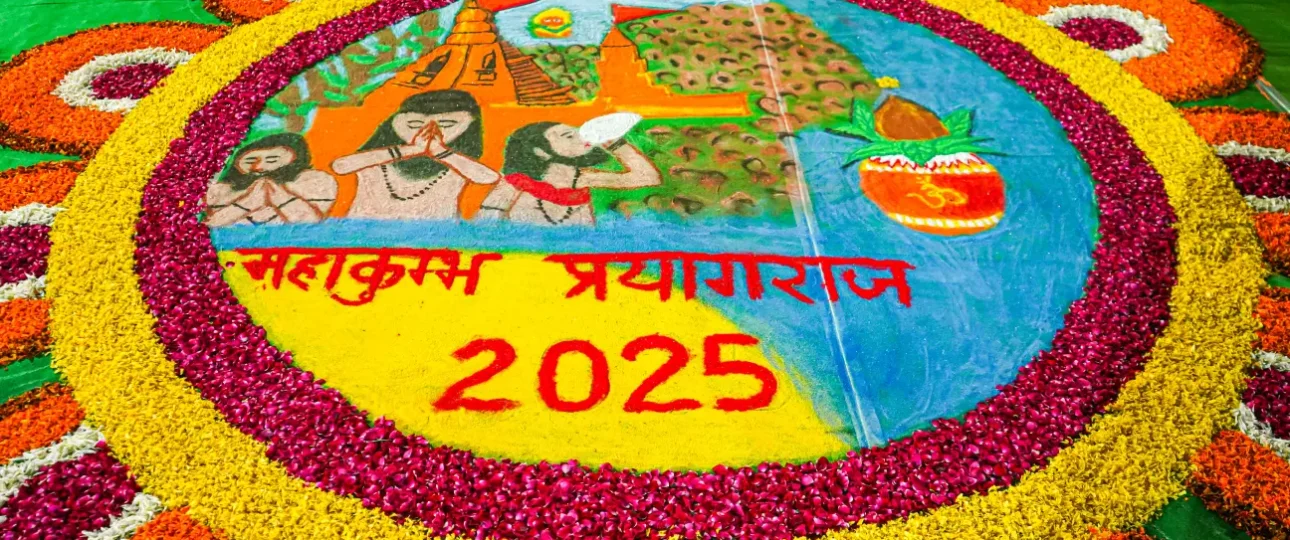The ancient city of Prayagraj (formerly Allahabad) holds profound spiritual significance in Hindu tradition, serving as one of the most sacred pilgrimage sites in India. At its heart lies the Sangam, the divine confluence of three holy rivers that draws millions of devotees during the Mahakumbh festival. This comprehensive guide explores the sacred geography of Prayagraj and its spiritual importance in Hindu culture.
The Divine Confluence: Understanding Sangam
The Sangam represents the meeting point of three sacred rivers:
- The Ganga (Ganges): Representing purity and spiritual cleansing
- The Yamuna: Symbolizing consciousness and spiritual awakening
- The mythical Saraswati: The invisible river representing knowledge and wisdom


This triveni sangam (three-river confluence) is believed to be the site where drops of immortality (amrit) fell from the Kumbh (pitcher) during the cosmic churning of the ocean (Samudra Manthan). Hindu texts describe this location as a gateway between earthly and celestial realms, making it particularly auspicious for spiritual practices.
Key Sacred Locations in Prayagraj
Akshaya Vat (Immortal Banyan Tree)
Located within the Allahabad Fort, this ancient banyan tree is believed to have survived the great flood (Pralaya). According to Hindu mythology, Lord Rama, Lakshmana, and Sita rested under this tree during their exile. The tree symbolizes eternal life and spiritual resilience.

Allahabad Fort
Built by Emperor Akbar in 1583, this fort houses several sacred sites including:
- The Patalpuri Temple: An underground temple dedicated to Lord Shiva
- The Saraswati Koop: A well believed to be connected to the mythical Saraswati River
- The Hanuman Temple: A significant shrine dedicated to Lord Hanuman

Hanuman Mandir
This temple near Sangam is unique because the idol of Hanuman is in a reclining position, unlike the usual standing posture. Local tradition holds that the temple was established by Sage Bharadwaj himself.

The Mahakumbh: Spiritual Significance of Locations
The Mahakumbh, occurring every 12 years, transforms Prayagraj into the world’s largest spiritual gathering. Different locations play specific roles during this festival:
Main Bathing Ghats
- Sangam Nose: The most auspicious bathing spot where the rivers meet
- Ram Ghat: Associated with Lord Rama’s visit during his exile
- Saraswati Ghat: Dedicated to the goddess of knowledge
- Dashashwamedh Ghat: Site of ancient Vedic rituals

Spiritual Sectors (Kumbh Mela Ground)
- Sector 1: Reserved for ancient akharas (religious orders)
- Sector 2: Dedicated to saints and spiritual leaders
- Sector 3: Main area for general devotees
- Sector 4: Cultural and religious discourse venues
Astrological Significance
The timing of the Mahakumbh is determined by specific astronomical alignments:
- Jupiter’s position in Aries
- Sun and Moon in Capricorn
- Specific lunar positions during bathing dates
These celestial alignments are believed to enhance the spiritual energy of these locations, making them particularly powerful during the festival.
Preservation and Modern Challenges
The sacred geography of Prayagraj faces several contemporary challenges:
- Environmental concerns affecting river water quality
- Urban development pressure on historical sites
- Infrastructure needs during massive gatherings
- Conservation of ancient temples and ghats
Local authorities and religious organizations work together to preserve these sacred sites while accommodating millions of pilgrims during festivals.
Practical Information for Pilgrims
For those planning to visit these sacred locations:
- Best visiting times: October to March
- Important festivals: Magh Mela (annual), Ardh Kumbh (every 6 years), Mahakumbh (every 12 years)
- Recommended duration: 3-5 days to explore all major sites
- Essential items: Appropriate clothing, offerings for temples, water bottle
Embark on a soul-stirring journey where ancient rivers converge and timeless traditions dance with divinity at Prayagraj, where every grain of sand whispers stories of spiritual awakening and celestial blessings await at the sacred Sangam.
Book Now Prayagtouristguide
Call Us : 9235645523, 9519583338, 9451230835
Email : info@prayagtouristguide.com.com

Conclusion
The sacred geography of Prayagraj represents a living tradition where physical locations intersect with spiritual beliefs. Understanding these sites’ significance enhances the pilgrimage experience and helps preserve this rich cultural heritage for future generations. Whether during the Mahakumbh or regular times, these locations continue to serve as powerful centers of spiritual energy and cultural significance.
Prayagraj, Sangam, Mahakumbh, triveni sangam, Allahabad Fort, sacred geography, Hindu pilgrimage, Akshaya Vat, sacred sites India, Kumbh Mela grounds





[…] Location and Transportation see Prayagtouristguide […]